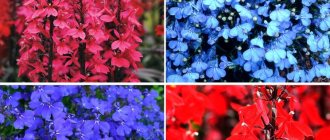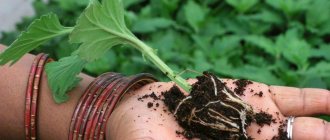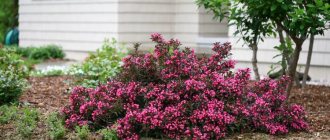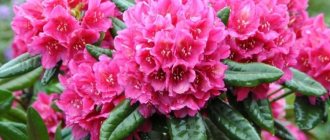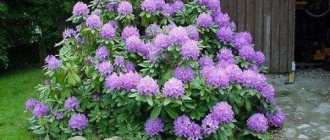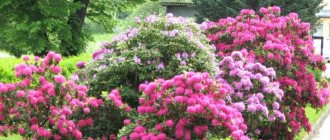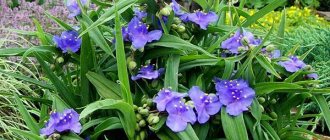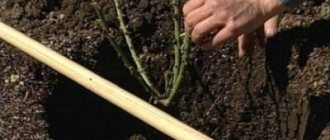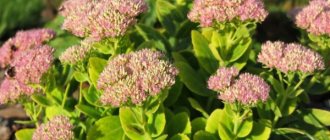Rhododendron is a hybrid plant of the heath family known as azalea. Depending on the species, the flowering period of the crop may differ. Also, the time of active flowering is influenced by the timing of rhododendron transplantation and how correctly the technical process was carried out. To ensure the plant blooms abundantly, you should adhere to several rules regarding room illumination, temperature, humidity, soil composition and the availability of nutrients.
Timing for planting rhododendron in spring
First, let's figure out when to plant rhododendrons in the spring in the Moscow region and the middle zone in general. Of course, this can be done in the fall, but before the cold weather there is a high probability that it will not take root or, without getting stronger, will freeze. Therefore, after all, spring is the best time to plant this ornamental shrub.
To plant seedlings, it is better to choose a period when the soil has already receded and warmed up a little, but at the same time still contains a sufficient supply of moisture. High humidity is a prerequisite for good survival. For the middle zone, this is usually April. In principle, rhododendron with a closed root system can be planted throughout the spring and summer, but you should not do this during its flowering, when it is most vulnerable.
Rhododendron in Siberia and the Urals will receive the necessary conditions later, due to a more severe climate. Typically, planting begins in early May.
How to plant rhododendron in spring: main steps
The foundation for a plant's well-being must be laid from the very beginning. To do this, you need to properly organize the following steps:
- choose a place;
- prepare a planting hole;
- lay suitable soil;
- plant correctly.
If everything is done correctly and the rhododendron gets what it “wants,” then caring for it will not differ from caring for most garden crops.
Types and varieties
Canadian and Daurian rhododendrons are considered suitable for cultivation in the conditions of the Moscow region, Leningrad region, the Urals and even Siberia. Varieties for these regions must tolerate frosts down to minus 25 degrees Celsius. The most popular among them:
- Grandmother.
- Golden Lights.
- English Roseum.
- Karens.
- Mount St. Helens.
- Nova Zembla.
- Roseum Elegance.
- Rosie Lights.
- White Lights.
Ofazende.ru recommends! Types and varieties of rhododendron
Choosing a place for rhododendron
Most gardeners face this problem. In a small area, sometimes it can be difficult to find a place that would be completely satisfied with the shrubs. Firstly, rhododendron does not like direct sunlight, especially in the summer heat. To plant it, you need to either choose shaded areas, for example, near some trees, or those where the sun looks only in the morning and evening, but not at noon.
A well-groomed rhododendron blooms especially beautifully
It would seem that the place for rhododendron is on the north side, in the shade of buildings or large trees. But it also does not tolerate cold winds from the north, so if you have chosen such a place, then there must be wind protection - a hedge or a solid fence. In the same way, it must be protected from the prevailing winds in your area. At the same time, you need to take into account that rhododendron needs a constant change of air and it is not worth planting it in all sorts of “nooks and crannies”.
Experienced gardeners recommend choosing the right partners for rhododendron if you plan to plant it near trees. Thus, it is undesirable to place it near spruce, red oak, willow, linden, and birch, since due to the type of their root system the shrub will lose the necessary nutrition.
Rhododendron bush in a garden composition
The best neighbors of rhododendron are:
- pine;
- larch;
- fir;
- juniper.
In addition to the fact that they have different nutritional horizons with the shrubs, the coniferous litter of these trees additionally acidifies the soil, creating the best conditions for rhododendron. In the absence of these conifers, it can be planted near pedunculate oak, plum, pear, apple, ash, and lilac.
Despite all its moisture-loving properties, places with close water or lowlands with poor drainage are contraindicated for rhododendron.
Features of the azalea life cycle in autumn
In the autumn, the plant is prepared for wintering (pruning and covering). The flowering and condition of rhododendron next season depend on the quality of these actions. It is important for a gardener to know the slightest nuances and rules for preparing flowers for hibernation in the fall.
Reference. The word “rhododendron” literally translated from Greek means “rose tree” or “tree with roses”, but it has nothing to do with roses. Their connection is only in the beauty of flowering, a wide variety of types and varieties.
In the fall, pruning of bush plants is done - one of the mandatory and very important processes. All perennial plant species are exposed to it, rhododendron is no exception.
Types of possible pruning:
- sanitary;
- rejuvenating;
- formative.
At the end of autumn, as soon as the first frosts set in, the rhododendron bushes are tied with rope and covered with plastic wrap or a bag. This makeshift hut must be removed immediately after the snow melts.
The deciduous species tolerates winter well in temperate climates. Can survive frosts down to 10 degrees without shelter. If the temperature drops below, you will have to use burlap.
Evergreen varieties of rhododendrons tolerate low temperatures less well. Bushes need additional shelter, as they often break branches under the weight of snow cover or strong winds. It is best to build a small insulating structure over the bush to protect the plant.
Soil for rhododendron
Rhododendron greatly depends on what kind of soil it gets. First of all, you need to pay special attention to its acidity. Alkaline or even neutral ones do not suit him well. The acidity level should be from 3.5 to 5 pH. If the pH values are higher, it is necessary not only to fill the planting hole with suitable soil, but also to acidify the soil during planting and do this regularly in the future.
Soil for hydrangeas and rhododendrons “Bona Forte”
Rhododendron likes soils that are loose, light, well-drained and breathable. They should be nutritious, with a lot of organic matter. On heavy soils (clays and loams) it develops poorly, blooms poorly and may die.
To fill the holes, use a mixture of pine litter with high-moor peat or soil for hydrangeas and rhododendrons “Bona Forte”. The composition of the finished Bona Forte mixture fully meets the requirements of these plants and has the required acidity.
“Prepare your sleigh in summer”
To cover or not to cover? Rhododendron owners ask themselves this constant question every autumn and decide it in accordance with the conditions of the site, their capabilities and attitude towards the culture as a whole. I'm covering. Perhaps in the future, when a protective “Mannerheim line” of coniferous plants grows around the rhododendrarium, I will limit myself to tying branches against possible breaks and a large layer of mulch. The only exceptions would be young, recently planted rhododendrons or varieties with low winter hardiness. In the meantime, I’m not mentally ready to leave my pets without winter “apartments.” Winter experience 2018–2019 showed how important the strength of the shelter is. That winter there was an unprecedented amount of snow for our area. Always reliable frames of interconnected arches folded under the weight of snow and ice, burying ten-year-old mature bushes. Branches broken at the base with several dozen flower buds that were never destined to open had to be cut out. Only the metal rod frames above the free-standing rhododendrons withstood the snow load. Therefore, in the fall of 2022, it was decided to build a collapsible frame of wooden blocks over a group of four rhododendrons, the crowns of which had long since closed into a single mass.
Let me note that the shelter turned out to be quite powerful - such protection from the sun, wind and frost should be enough for several years. There were many interesting and funny suggestions from friends about using such an outstanding structure in the summer. For example, move it to a cucumber bed, or cover the ends with a net and have chickens. My plan was to dismantle the frame until next fall, but after assessing the amount of work, I left it as a kind of gallery for rhododendrons, removing only the top boards. By the way, the builders and authors of the “remake” were pleased with my decision, considering it wise and extremely successful.
Last winter my new frame was never fully tested, because there was almost no snow. Although, this is a different way to look at it, because it is not known for certain what the next winter will be like.
There were no problems at all with covering small bushes. Everything happened very quickly. I simply transferred the “support stools” that I talked about in the second part of “Peony Mania” from peonies to rhododendrons.
Preparing the planting hole
Rhododendron seedlings have a small, superficial root system. However, since the soil on the site rarely meets the requirements of this heather shrub, the planting hole must be large to accommodate a sufficient amount of soil for further growth. On average, it is made about 70 centimeters in diameter and up to 60 cm in depth. If you plan to plant some plants, the distance between the holes should be at least 1 meter.
It is advisable to place a thick drainage layer (15-20 centimeters) of expanded clay, crushed granite stone, broken ceramics or red brick at the bottom of the pit; it will help remove excess moisture and prevent the roots from rotting during prolonged rains.
Short description
Today the genus has many varieties, among which you can find deciduous, semi-deciduous and evergreen shrubs.
In nature, it grows in the subtropical and temperate climates of the Northern and Southern Hemispheres. Most species are concentrated in China, Australia, the Himalayas, Japan, New Guinea and North America.
On the territory of the Russian Federation, 18 varieties are common in natural growing conditions. The main regions are the Caucasus, the Far East and Siberia.
It can grow as shrubs, shrubs or small trees. Depending on the species, the size of the plant may vary. The average stem height of some varieties is 30 cm.
Rhododendron is characterized by a wide variety of variants of leaf blades of shoots. Their shape and size depend on the type of crop; they can be:
- leathery;
- perennial (evergreen);
- obovate;
- annuals;
- pubescent;
- regular;
- serrated;
- with and without petioles;
- entire;
- ovoid.
The flowers have an irregular corolla and can be arranged in large corymbose inflorescences or racemes. There are also single or combined 2 pieces. The diameter of the flowers of some varieties reaches 20 cm, while others, on the contrary, grow small.
The most famous representative of the indoor-growing genus is called azalea.
At the end of the season, the fruit ripens - a box with 5 doors, which opens from the top down. The seeds are small, 0.5-2.0 mm long.
During the first time after planting, slow growth is observed. The roots are fibrous, grow compactly and superficially.
Some varieties are considered poisonous. The content of andromedotoxin makes it dangerous for people and animals.
Before planting rhododendron on the site, it is worth determining the location correctly. It is recommended to choose remote areas of the garden or distant flower beds that are inaccessible to small children and pets. When working with seedlings, it is necessary to use personal protective equipment - disposable gloves and safety glasses.
Related article:
Rhododendron plant
Planting rhododendron
We purchased rhododendron seedlings, chose a place and prepared holes, now all that remains is to plant them correctly.
Granular fertilizer for hydrangeas and rhododendrons “Bona Forte”
The planting hole is filled with ready-made soil so that the root ball of the seedling, when installed in the center, is at the top level with the edge of the hole. It is advisable to add granular fertilizer for hydrangeas and rhododendrons “Bona Forte” to the hole. Thanks to its balanced composition and prolonged action, it will provide the seedling with everything necessary throughout the growing season and improve survival rate.
After this, the next portion of soil is poured around the lump so that the root neck of the seedling must remain uncovered, and then it is lightly compacted.
After planting, the soil must be watered very well; each seedling should receive at least 20 liters of water. Then the pit is mulched with a thick layer of fallen pine needles, peat or sawdust. Mulch delays the evaporation of soil moisture and stabilizes the soil microclimate.
How to feed the plant
When rhododendron is transplanted, a small amount of mineral fertilizers is already added to the soil mixture. The next feeding is done 3-4 weeks after planting, when the plant takes root.
In the spring, before flowering, plants are fertilized with organic mixtures - blood meal, half-rotted cow manure or horn meal. You can infuse the manure for 3-4 days in water, and then water the ground around the bushes with the resulting slurry, but first moisten the ground well with plain water.
Mineral fertilizers that do not contain chlorine - superphosphates, nitrogen, phosphorus and sulfate substances such as potassium, calcium, ammonium, magnesium - have a good effect on the growth and development of shrubs.
Important! In summer, from mid-June until September, fertilizing is not carried out.
Proper transplantation is the key to good growth, development and flowering of the bush
Outdoor care for rhododendron
Despite all its unpretentiousness, rhododendron needs basic garden care. It includes standard procedures:
- watering;
- feeding;
- mulching;
- small trimming.
The unearthly flowers of rhododendron will decorate any area
. We have already said that the Bona Forte fertilizer is well suited not only for planting, but also for periodic feeding. To do this, the granules are scattered over the surface and slightly buried during loosening. Fertilizers for rhododendron in the spring should contain not only standard phosphorus, nitrogen and potassium, but also many microelements. Do not forget that the root system of all rhododendrons is superficial and quite vulnerable, so you need to loosen the tree trunk circle very carefully, without affecting the deep layers of the soil. For the same reason, it is better to remove weeds manually, without using hoes.
Good watering is a prerequisite for the well-being of rhododendrons. The upper layers of soil, which are occupied by the root system, dry out quite quickly. The soil should always be moist, but not soggy. It has already been said that the bush does not like stagnant water almost as much as it does drought. Therefore, the need for watering will need to be monitored visually, since the frequency depends on the general air temperature, the drainage properties of the soil, the phase of plant growth, and the time of year.
Rhododendrons do not always need formative pruning. Bushes of many varieties grow quite compactly. In tall varieties, shoots that are too long are pruned; pruning is also needed if you want to give the bushes a certain shape or increase branching.
Rejuvenating and sanitary pruning should be carried out in early spring, while the bushes have not yet awakened. At this time, old and frozen shoots are cut out, the first at a height of 20 to 40 centimeters from the ground, the second completely. When rejuvenating, it is necessary to leave a few old shoots, which will need to be removed next year, then pruning for rhododendron will not be a shock.
Mulching the soil
A prerequisite is mulching to prevent the soil from drying out.
After flowering, you need to break off the inflorescences so that the plant does not waste its energy on ripening seeds (if they are not needed), but directs them to the formation of new flower buds.
Answers to readers' questions
Plant lifespan
Some species, such as Katevba rhododendron, can grow up to 100 years. Most species in cultivation can live more than 30 years.
Why doesn't the flower bloom?
Rhododendron may not bloom for several reasons:
- The plant was grown from seed and has not yet reached flowering age;
- The landing site was poorly chosen;
- Flower buds suffered from spring frosts or were pecked by birds.
Why do the leaves turn yellow (dry)?
In deciduous rhododendrons, the leaves turn yellow in the fall for natural reasons. At other times, yellowing of the leaves may be due to insufficient watering or, conversely, to flooding of the plant and rotting of the roots. Drying leaves may be caused by pest damage.
Treatment of rhododendrons in spring
Treatment of rhododendrons in the spring against various diseases and pests is also important. Among the diseases for this representative of heathers, chlorosis, rust, spotting, rot, including gray rot, bacterial cancer, and mosaic are dangerous. To protect against them, preventive treatments are carried out with various preparations, from Bordeaux mixture to copper sulfate, fungicides.
Treatment of rhododendrons
Rhododendron can be attacked by pests such as:
- weevils;
- spider mites;
- thrips;
- whiteflies;
- false scale insects.
Universal spray against aphids, spider mites and other insects "Bona Forte"
If you are thinking about the best way to treat rhododendron in the open ground in the spring to get rid of all these pests, pay attention to the universal spray against aphids, spider mites and other insects "Bona Forte" " This remedy, thanks to the lambda-cyhalothrin included in its composition, effectively acts on any insects that may threaten the bush, including spider mites - one of the most unpleasant pests.
You can read about the fight against spider mites in the article: “Spider mites on plants: what they look like and control measures.”
By planting a rhododendron in the garden and following all the rules for caring for it, from early spring you will be able to admire the caps of beautiful delicate flowers with a sweet honey aroma.
Step-by-step instructions on how to carry out cuttings
The presented algorithm of actions is suitable for deciduous species. Reproduction occurs by cuttings.
Necessary equipment
For planting you will need boxes or boxes. If it is necessary to accelerate growth, you can plant cuttings in greenhouses or greenhouses. They are also planted in open ground, but regular watering, growth control and compliance with suitable conditions will be more difficult to carry out.
Place
Rhododendrons are quite whimsical plants. They are not suitable for planting in dry and cold climates. They love shady places, coolness and water, but can easily bloom with constant exposure to sunlight. The best place for planting is the northern, shady zone of the site. The soil should be loose, filled with humus.
Plants ideally take root near bodies of water with moist air. If there is no water nearby, the bushes need to be sprayed once a week until flowering begins. It is recommended to choose the right neighbors for the plant.
Do not plant bushes next to trees such as:
- Linden;
- chestnut;
- maple.
The root systems of these trees are at approximately the same depth and can take all the nutrition from the new plant.
Note! The best neighborhood options are apple trees, pear trees, and coniferous trees.
Setting the stage
For cuttings, use special ready-made acidic earth mixtures or self-prepared soil mixtures. A mixture of peat, coniferous soil and sand in equal proportions is suitable for the plant.
Process
Rhododendrons have a fibrous root system. Plants easily tolerate planting, but die when flooded. When planting cuttings, you need to make a shallow hole so that they grow at soil level and do not go deeper after the soil settles. If there is close underwater water in the area (level less than 1 m), good drainage must be made in the planting hole.
It is best to harvest seedlings for planting in the second half of July. To do this, leaves are cut from the shoots along with the axillary bud and wood in the form of a shield with parallel edges of short length. For deciduous species (azaleas), it is better to choose apical cuttings. If there are a lot of flowers on the bush, then they need to be cut off so that all the plant’s forces are directed to rooting growth, and not to flowering.
From cuttings that are cut, it is necessary to remove the lower leaves, leaving a couple of upper leaves. It is not necessary to shorten the remaining leaves on the cuttings. The cut is made at an angle of 45 degrees.
There is also pre-treatment of cuttings:
- Soaked in growth stimulants. It is necessary to immerse the lower sections in the rooting solution for about a day.
- Containers are filled with soil and leveled.
- Leaf cuttings take root within 5 months.
First watering
The first time to water the plant after planting is 3-5 days. At the same time, it is important not to flood the roots; the moisture should not stagnate. Next is the watering schedule: once a week.
Outdoor care
Important! The main components of proper care are regular and proper watering, spraying, fertilizing, creating the shape of the bush, prevention and control of diseases and parasites.
What is important for a gardener to consider:
- It is forbidden to loosen the soil near the rhododendron bush. This is due to the fact that the roots of the plant are quite close to the surface. It is better to pull out weeds by hand without using garden tools.
- In dry autumn, the flower requires abundant watering (on average 10 liters of water). In rainy autumn, you can forget about watering.
- You need to water the bushes with soft water (rain or settled water). The frequency of watering can be determined by the leaves. If they become dull and begin to lose elasticity, then it’s time to start watering. The soil should be moistened to a depth of 30 cm.
- Do not flood the roots of rhododendrons with water. This plant is very sensitive to oversaturation of water in the roots, so they react in exactly the same way as to drought (wither).
- In November, they begin to insulate each bush by laying a layer of peat nearby.
Trimming
Rhododendron requires proper pruning. This action stimulates the development of the bush and the appearance of new shoots.
In the spring, sanitary pruning of frozen, dried out, dead branches is performed. Periodically it is necessary to carry out anti-aging pruning, removing all shoots, including old ones.
Caring for rhododendron after the flowering period involves removing faded inflorescences. In general, each variety has its own pruning scheme, which is associated with the flowering period and adaptability to different climatic conditions.
Reproduction methods
Garden rhododendrons can be planted by layering, cuttings and sowing seeds. To germinate layering in the spring or at the very end of summer, dig a groove 15-20 cm deep next to the bush, bend one of the branches to it and sprinkle it with earth. To speed up the process, you can slightly damage the layer of bark on the shoot, which will end up in the soil. Rooting lasts for 2 years.
Cuttings for rhododendron propagation are prepared in early June from annual shoots. From branches 10-12 cm long, cut at an angle of 45 degrees, the lower leaves are removed, leaving only 2-3 in the upper part. Next, the cuttings are planted in the ground at a distance of at least 5 cm from each other, building a greenhouse over them. After about 2-3 months, the seedlings will give roots.
For reference: the seed propagation method is less popular due to the risk of losing most of the crops in the fight against fungal infections, and the plant will bloom no earlier than in 5-10 years.
Propagation of rhododendron by layering and cuttings
The seeds are planted at the end of winter in a spacious container with drainage holes, covered with film. After about 1.5 months of being in a dry, bright place, they germinate (the film must be periodically opened to ventilate and moisten the soil). Grow seedlings at cool temperatures. It will be possible to plant seedlings in the ground only after 3 years.
